The Gardenia, a timeless favorite in wedding floral arrangements, is celebrated for its pristine white petals and enchanting fragrance, epitomizing purity and joy. Its elegance and sophisticated charm make it an ideal choice for creating a romantic ambiance. Originating from tropical and subtropical regions, the Gardenia’s lush appearance adds a luxurious touch to any wedding setting. But what makes this flower truly unique in its cultural significance and versatility in wedding decor? Understanding the various dimensions of the Gardenia can elevate your floral choices to new heights.
Flower Overview
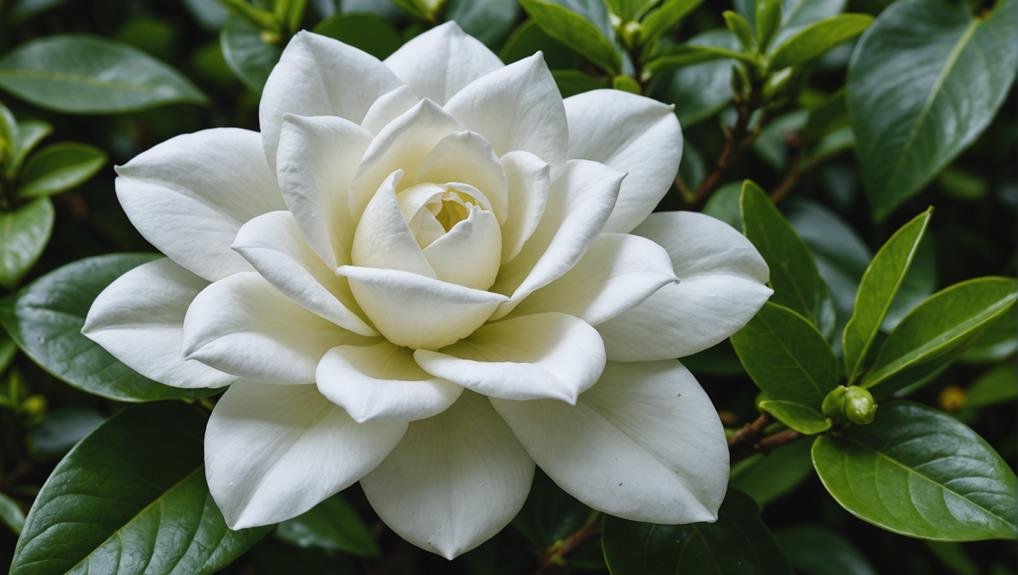
Gardenias, celebrated for their striking white or pale yellow blooms and enchanting fragrance, are a quintessential choice for wedding floral arrangements. These flowers are not only visually appealing but also carry significant symbolic meaning. Representing purity and joy, gardenias are often selected for weddings to embody the essence of a couple’s love and commitment.
Their highly fragrant nature makes them an ideal addition to any bridal bouquet or centerpiece, providing a sensory experience that complements the visual beauty of the event. The pure white color of gardenias is particularly significant in wedding traditions, symbolizing innocence and the beginning of a new journey together.
Their delicate fragrance adds an element of romance and sophistication, elevating the ambiance of the event. Despite their beauty and symbolism, gardenias are known to be delicate and relatively expensive, often reserved for special occasions like weddings.
Available primarily from mid-spring to summer, these blooms can sometimes be sourced year-round through select florists. Gardenias are also culturally significant, serving as the national flower of Pakistan and famously associated with jazz singer Billie Holiday, who frequently wore them in her hair.
Their elegance and purity make them a timeless choice for wedding floral arrangements.
Physical Description
With their beautiful white or pale yellow blooms, typically featuring 5-12 petals and reaching diameters of 5-12 cm, gardenias are a visually enchanting choice for floral arrangements. Their elegant appearance makes them a popular selection for weddings, especially for the bridal bouquet, where their aesthetic qualities can be fully appreciated. The pristine white blooms of gardenias are often associated with purity and joy, further enhancing their appeal for matrimonial celebrations.
Beyond their visual allure, gardenias are highly fragrant, adding a delightful scent that can permeate an entire room. This fragrance is a key reason they are favored in bridal bouquets and other floral arrangements, as it provides an aromatic complement to their visual beauty. The combination of their striking white blooms and enchanting aroma ensures that gardenias make a lasting impression on any wedding event.
In addition to their use in bouquets, gardenias have a rich history of being worn as boutonnieres, particularly in French tradition, signifying elegance and sophistication. The famous jazz singer Billie Holiday also frequently adorned herself with gardenias, highlighting their timeless glamour and adding to their cultural significance.
Available Colour Varieties
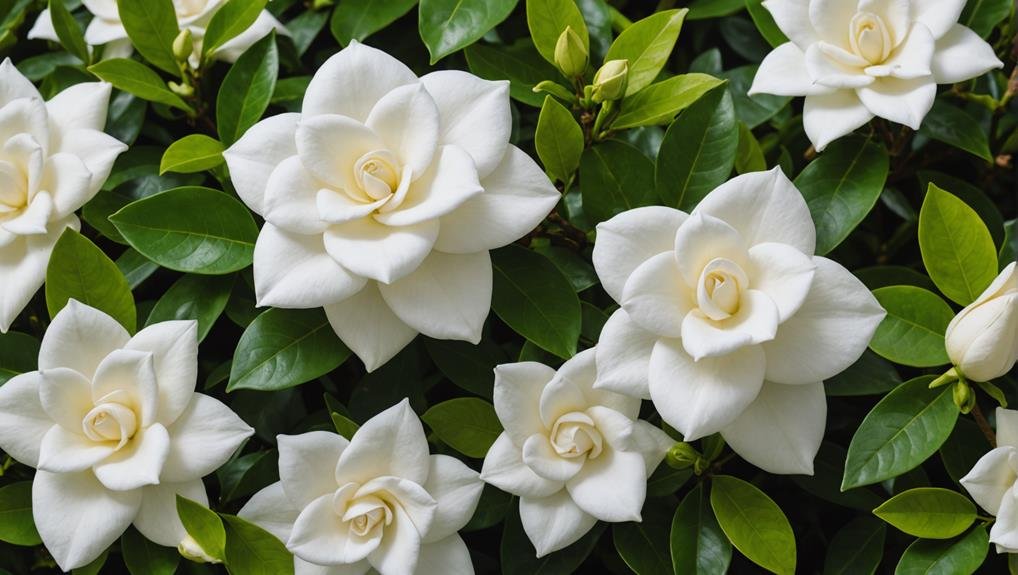
Though mainly known for their iconic white blooms, gardenias also come in a limited range of other colors, most prominently pale yellow. These subtle color variations allow for a touch of diversity while maintaining the classic elegance for which gardenia flowers are renowned.
The white petals of gardenia blooms are synonymous with purity and joy, making them an ideal choice for wedding arrangements and special occasions. Gardenia flowers typically feature 5-12 petals and can range from 5-12 cm in diameter, offering a prominent visual impact.
While the white variety is the most popular, the pale yellow gardenias provide an equally beautiful alternative, subtly enhancing floral compositions without overpowering other elements. Despite their limited color palette, the timeless appeal of these flowers lies in their simplicity and sophistication.
Gardenias are not only aesthetically pleasing but also highly symbolic. Their availability in both white and pale yellow guarantees that they can be incorporated into a wide range of wedding themes and color schemes. Additionally, gardenias are available year-round from select florists, allowing for flexibility in event planning.
This year-round availability guarantees that these exquisite blooms can grace weddings regardless of the season.
Latin Name and Taxonomy
Belonging to the Rubiaceae family, Gardenia jasminoides is the scientific name for the gardenia, a genus that encompasses over 140 species of flowering plants. This classification places gardenias among other notable members of the Rubiaceae family, known for their diverse and often ornamental characteristics. Gardenia jasminoides, in particular, is celebrated for its striking, fragrant blooms that make it a popular choice in wedding floral arrangements.
Taxonomically, gardenias fall under the order Gentianales, which includes a variety of flowering plants known for their therapeutic and decorative uses. The Latin name, Gardenia jasminoides, aptly reflects the plant’s jasmine-like fragrance and visual appeal, making it a beloved choice among florists and horticulturists alike.
To summarize the key points:
- Family: Rubiaceae
- Order: Gentianales
- Scientific Name: Gardenia jasminoides
- Species Count: Over 140 species
Understanding the taxonomic classification of gardenias provides valuable insight into their botanical characteristics and their place in the broader spectrum of flowering plants. This knowledge is particularly useful for those planning floral arrangements, ensuring that gardenias are appropriately selected and paired with complementary species.
In the next section, we will explore the geographical origins of Gardenia jasminoides.
Geographical Origins
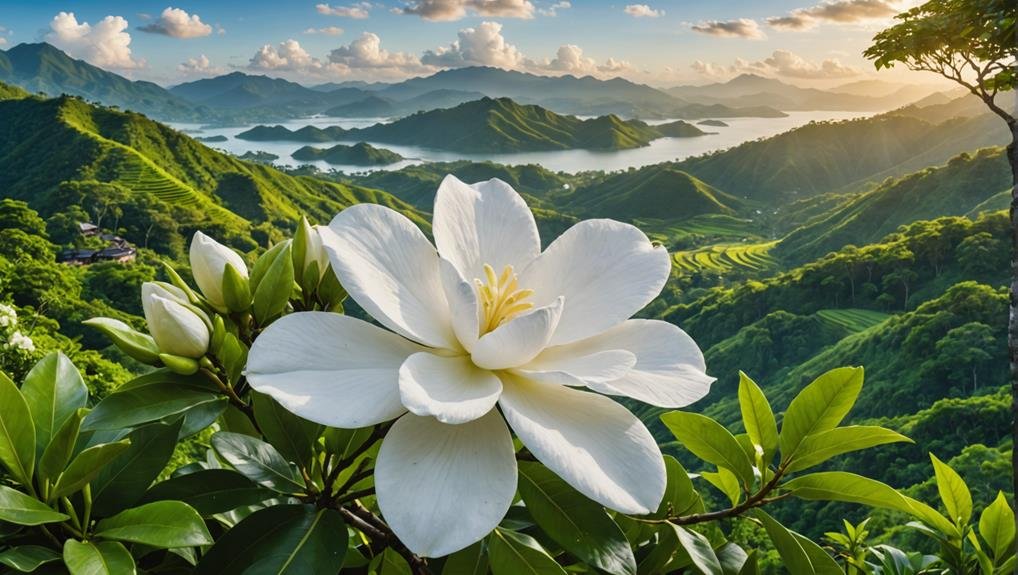
Native to tropical and subtropical regions, gardenias flourish in diverse climates across Africa, Asia, Australasia, and Oceania. These fragrant flowers, part of the Rubiaceae family, have a rich history and thrive in humid environments. Their geographical origins extend to countries such as China, Japan, Taiwan, and India, where they grow abundantly. The plant’s ability to adapt to various climates within these regions has facilitated its widespread cultivation.
The gardenia’s name honors Dr. Alexander Garden, a Scottish-born American naturalist who made a significant contribution to botanical science. This historical nod reflects the plant’s long-standing cultural and botanical importance. In the tropical and subtropical regions of Asia, gardenias are particularly esteemed, often symbolizing purity and gentleness in local traditions.
Additionally, gardenias share their botanical family with notable plants like coffee and quinine-producing Cinchona trees. This connection underscores the economic and cultural significance of the Rubiaceae family across the globe.
Cultivated for centuries, gardenias hold a revered place in horticulture and continue to be a popular choice for weddings and other ceremonial occasions, thanks to their elegant appearance and enchanting fragrance.
Season Availability
Understanding the season availability of gardenias is vital for planning wedding floral arrangements, as these blooms typically thrive from mid-spring to summer. This period signifies the peak season for gardenias, guaranteeing that the flowers are at their freshest and most vibrant, perfect for creating stunning wedding bouquets and centerpieces.
However, it’s worth mentioning that availability can vary depending on the region, with some areas having better access to these delicate and luxurious blooms.
For those planning weddings outside the peak season, it’s worth considering that some florists offer gardenias year-round. This flexibility allows brides and grooms to incorporate gardenias into their wedding decor regardless of the time of year.
When choosing gardenias outside their natural blooming period, it is essential to work closely with a florist to maintain the flowers’ quality and freshness.
Growing Conditions
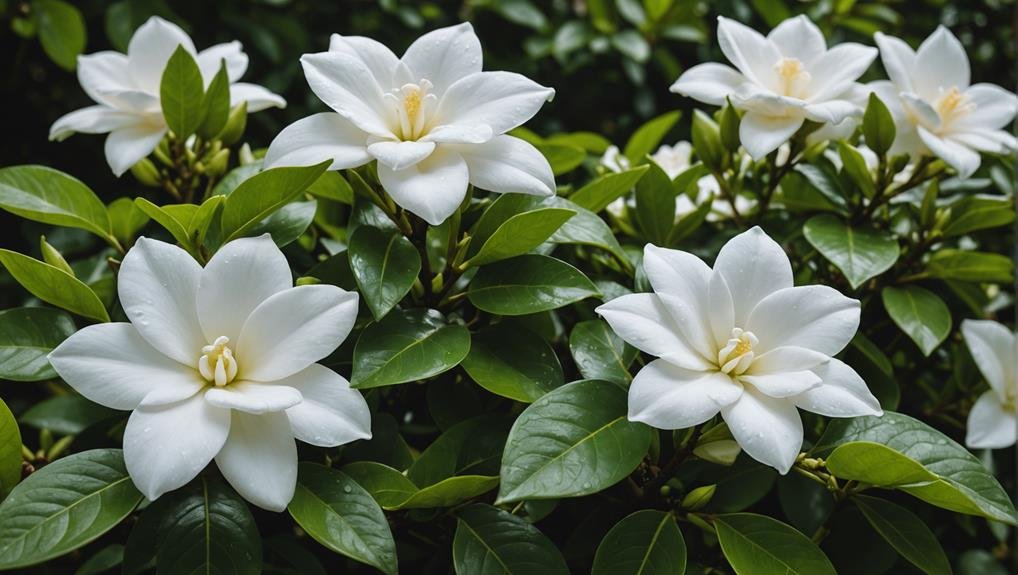
To cultivate gardenias successfully, it is necessary to provide them with acidic soil that has a pH of 5.0-6.0 and is rich in organic matter. These enchanting flowers, often chosen for weddings, thrive best in well-draining soil conditions. Ensuring the soil remains consistently moist but not waterlogged is crucial, as gardenias are susceptible to root rot if overwatered.
Gardenias prefer partial shade to full sun exposure, especially requiring protection from the harsh afternoon sunlight in hotter climates. Regular watering is vital for maintaining the health and vibrancy of the gardenia, promoting the lush green foliage and fragrant blooms that make them a wedding favorite. Additionally, gardenias benefit significantly from regular feeding with a fertilizer specifically formulated for acid-loving plants, which supports their overall growth and bloom production.
Pruning is another key aspect of gardenia care. Pruning after flowering helps maintain the plant’s shape, promotes new growth, and improves air circulation, which is crucial for preventing common gardenia issues such as mold and pests.
| Aspect | Requirement |
|---|---|
| Soil pH | 5.0-6.0 |
| Sunlight | Partial shade to full sun |
| Watering | Consistently moist, not waterlogged |
Understanding these growing conditions is necessary for anyone looking to incorporate these elegant flowers into their wedding arrangements.
Cultural Significance
Throughout history, gardenias have held profound cultural significance across various regions and traditions, contributing to their enduring popularity in wedding ceremonies. These elegant flowers, particularly the White Gardenia, symbolize purity and joy, aligning perfectly with the sentiments of love and commitment celebrated in weddings.
In France, gardenias have been traditionally worn as boutonnieres by men, adding an elegant touch to formal occasions. This practice highlights the flower’s association with sophistication and refined taste.
Additionally, the gardenia is the national flower of Pakistan, representing beauty and national pride. This cultural reverence underscores the flower’s universal appeal and symbolic depth.
Billie Holiday, the iconic jazz singer, famously adorned her hair with gardenias, further cementing their connection to grace and elegance. This historical association with a figure known for her artistic and cultural impact elevates the gardenia’s status in the world of wedding flowers.
Key points highlighting the cultural significance of gardenias include:
- Traditional boutonnieres in France
- Symbol of purity and joy
- National flower of Pakistan
- Adorned by Billie Holiday
With their exquisite fragrance and symbolic meaning, gardenias continue to be a timeless choice for weddings, enhancing the overall elegance and emotional depth of the celebration.
Typical Use in Weddings
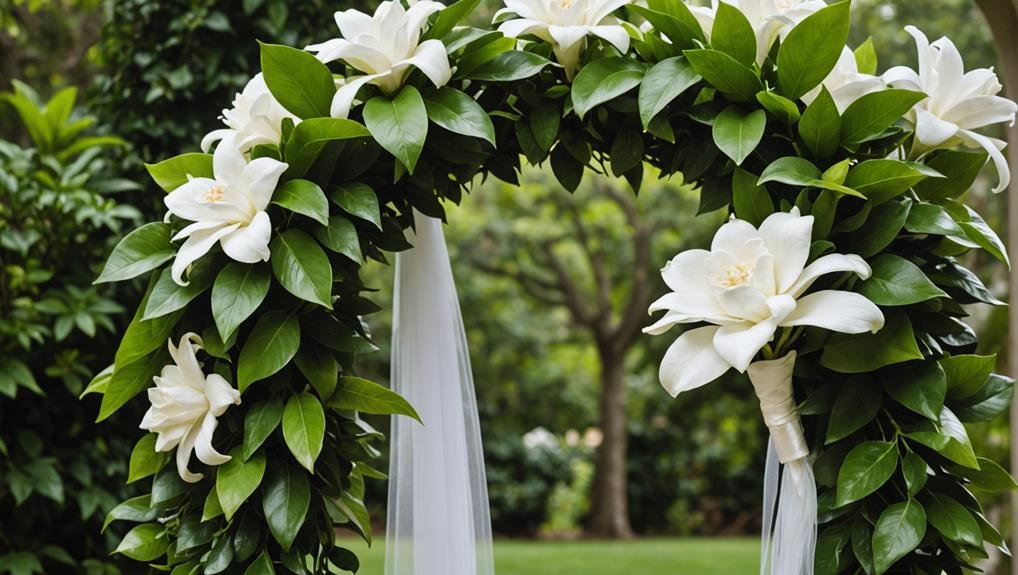
Gardenias, with their elegant appearance and delightful fragrance, are a favored choice for various wedding elements, including bouquets, boutonnieres, corsages, and floral arrangements. Their pristine white petals and lush green foliage create a timeless and sophisticated look, making them ideal for wedding bouquets. Couples often choose gardenias to add a touch of purity and joy, enhancing the sentimental value of their special day.
For those seeking gardenia bouquet ideas, incorporating these blooms into bridal bouquets can range from classic all-gardenia arrangements to mixed bouquets featuring gardenias alongside roses, peonies, or lilies. The versatility of gardenias allows them to complement a variety of wedding themes and styles, from traditional to modern.
In fall weddings, gardenias can be paired with seasonal foliage and deep-hued flowers to create a striking contrast, adding warmth and richness to the overall decor.
Beyond bouquets, gardenias are also commonly used in boutonnieres and corsages, adhering to the tradition of elegance and refinement. Centerpieces featuring gardenias, whether arranged in vases or floating in bowls with candles, contribute to a romantic and enchanting atmosphere, perfect for any wedding celebration.
Alternative Flower Types
A myriad of alternative flower types, such as peonies, dahlias, and orchids, can complement or even replace traditional wedding blooms to create distinctive and memorable arrangements. These flowers offer a variety of textures, fragrances, and colors that can enhance the overall aesthetic of wedding décor.
Peonies are favored for their lush, full blooms and romantic appearance. Available in a range of colors from soft pastels to vibrant hues, they can add a touch of elegance and charm to any bouquet.
Dahlias, with their intricate petal structures and diverse color palette, provide a striking contrast to gardenias and other traditional flowers. Their bold presence can create a dramatic focal point in floral arrangements.
Orchids, known for their exotic allure and sophisticated beauty, are another excellent choice. They bring a sense of luxury and modernity to wedding designs. Their long-lasting nature and unique shapes make them a versatile option for various wedding themes.
- Peonies: Lush, romantic blooms in various colors.
- Dahlias: Bold, intricate flowers that add drama.
- Orchids: Exotic, sophisticated, and long-lasting.
- Gardenias: Elegant and fragrant, perfect for vintage or romantic themes.
Incorporating these alternative flowers can result in a stunning and personalized wedding floral display.
